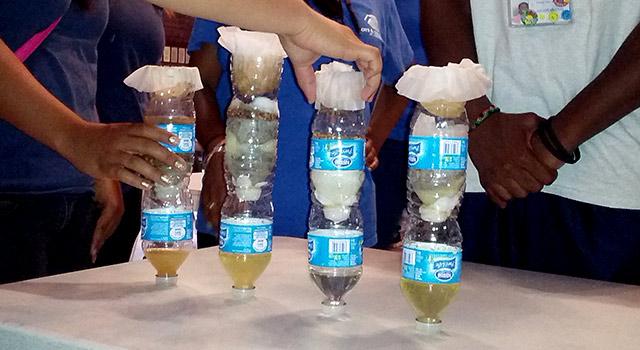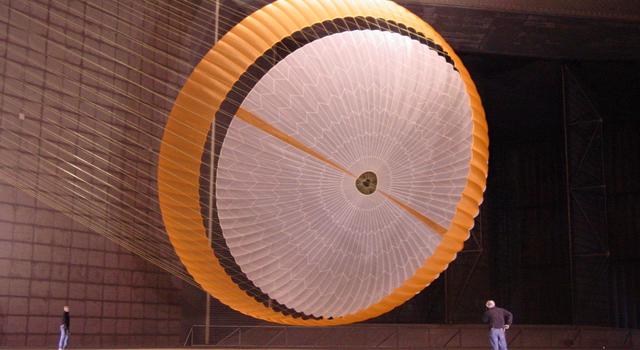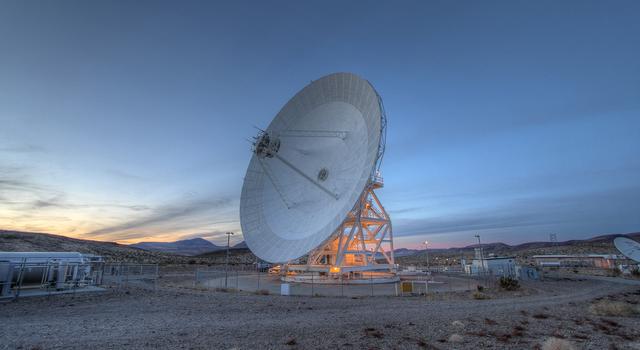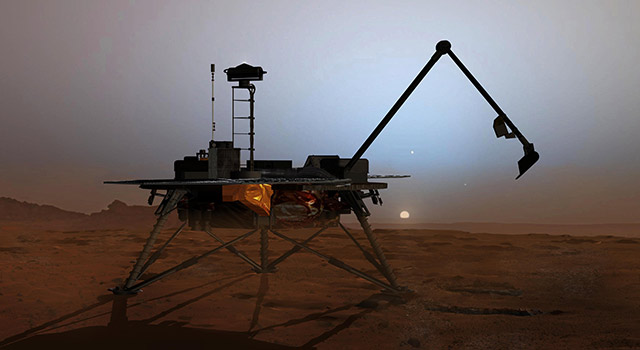Classroom Activity
Speaking in Phases
This activity is part of our Engineering in the Classroom tool for educators! Click to learn more about the Next Generation Science Standards (NGSS) for engineering, make connections to NASA and discover more standards-aligned activities.
Overview
NASA's Deep Space Network is a series of antennas used to communicate with far-away spacecraft. But the DSN doesn't send and receive sounds; it actually uses radio waves to communicate with spacecraft.
To help students
understand how these signals are used to send data back and forth across
the solar system, this activity teaches how signals travel at
the speed of light and are decoded. Fortunately, the signals students create in this
lesson are a bit slower. They
will realize pretty quickly that when these types of signals are not
going at the speed of light, it can take quite a long time to transmit a
message -- even from across the classroom. After completing the first part of this exercise, extend the
lesson by challenging students to design a faster way to send signals.
Materials
Management
- This is a whole-class activity, but students can work in small groups to practice transmission skills after the initial practice.
- When first starting, the teacher can be the "Sig" (explained below) in order to reduce errors while students are still learning the code. Once students are more familiar, any student wishing to be the Sig can volunteer.
- At first, it might be a good idea to stop after each pattern of four beats to discuss what the students heard and whether what they heard represents a 1 or a 0. After gaining familiarity, students will be able to hear patterns more easily and stopping won't be required as frequently.
Background
The Deep Space Network has three sets of antennas, spaced at locations more or less equidistant around the Earth. One set is in California, one set is in Spain, and one set is in Australia. So as Earth turns, at least one set of antennas is pointed in the direction of far-away spacecraft at all times. The DSN’s huge, dish-type antennas are specially designed to detect radio waves -- and very faint ones at that.
Radio waves are like light waves, but much longer, so our eyes cannot see them. Radio waves hit Earth all the time from stars, galaxies and even some planets (Jupiter is a good example). A little more than 100 years ago, humans learned how to make radio waves, too. Now we use them to carry the signals for our radio, TV and other types of communication on Earth, as well as to communicate with our spacecraft, whether in orbit around Earth or out in deep space.
How can a picture of Saturn or Jupiter be carried by very weak waves of radio energy passing through millions of miles of cold, empty space? First, let’s look at what we really mean by a wave. A wave appears on the surface of the ocean when a burst of energy passes through the water. Lots of bursts of energy in a short time make short, choppy waves. Fewer bursts of energy in the same time make longer, drawn out, more graceful waves — great for surfing. Light waves and radio waves are both electromagnetic energy. The only difference between them is the distance between successive waves. That distance is called wavelength. Electromagnetic energy comes in every wavelength in between these two, as well as waves much shorter than light waves and much longer than the radio waves we use for communication.
As a matter of fact, we don’t know how long or how short electromagnetic waves can be. We know only the ones we have eyes or instruments to detect. We could pick any wavelength to carry information as long as we could build an instrument that could transmit energy through the air or through space at that wavelength. But it turns out that light waves and shorter wavelengths -- besides taking more energy to transmit -- get scattered and absorbed easily by Earth’s atmosphere. Some short wavelengths (like X-rays and gamma rays) can’t penetrate air at all. That’s lucky for us, since these highly energetic waves would bombard Earth’s surface from space and eventually kill off every living thing!
Radio waves, however, pass through Earth’s atmosphere very nicely, without distortion. This property makes them ideal for sending signals. They also don’t require as much energy to produce as shorter wavelength electromagnetic waves. And, by the way, they don’t hurt anybody.
Frequency is another way to describe wavelength. Frequency refers to the time it takes for two crests (highest part of the wave) or troughs (lowest part of the wave) in a row to pass the same point in space. The longer the wave, the lower (or slower) the frequency (because it takes longer for the wave to pass a point). The shorter the wave, the higher (or faster) the frequency.
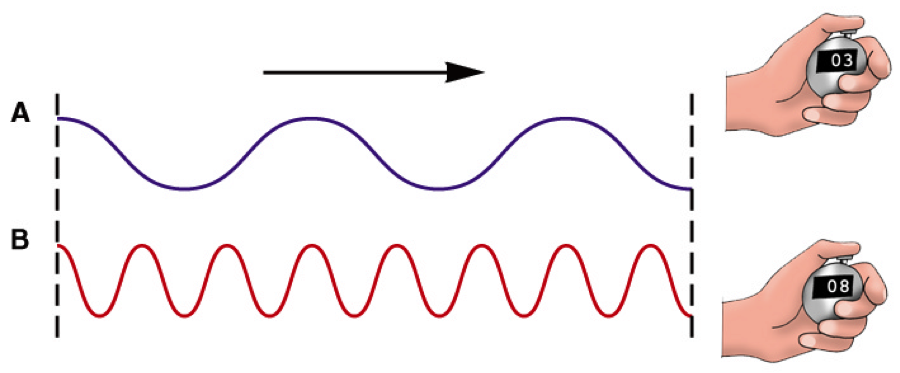
In the above illustration, more B waves than A waves will pass by a certain point in a certain time. So the shorter the wavelength, the higher the frequency. TV stations and some radio stations put their program information on the wave by adjusting the frequency. FM (as in FM radio stations) means frequency modulation. Modulation means changing a radio signal so that it carries information. Some radio stations use amplitude modulation (AM). Amplitude is the height of the wave from crest to trough.
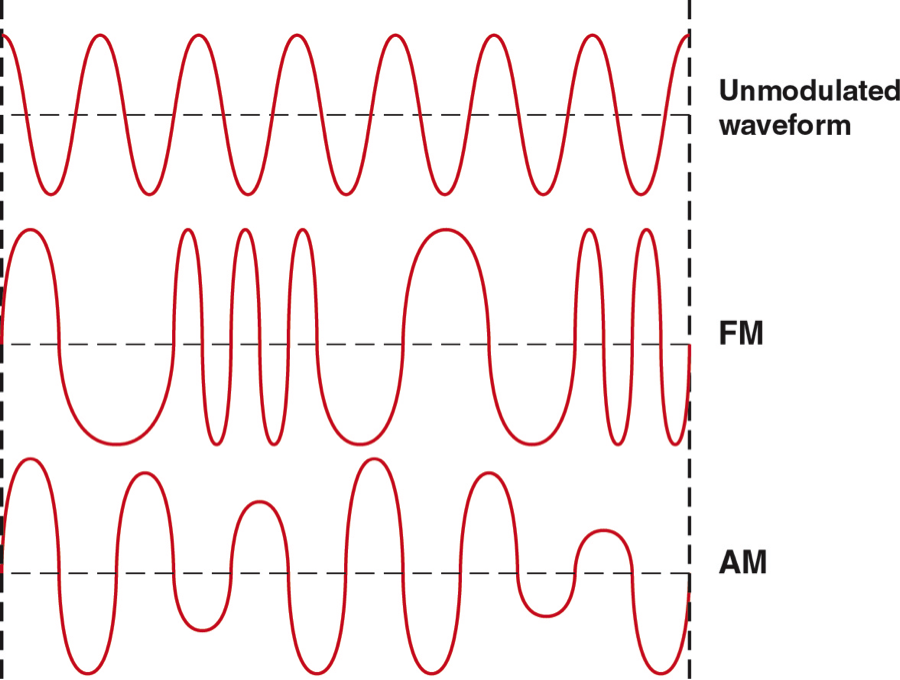
Spacecraft do not use either of these modulation methods, however. Spacecraft use phase modulation. Phase refers to the part of the wave passing a particular point at a particular instant. If two waves of the same frequency (that is, wavelength) are in phase, the exact crest or trough of both is passing the same point at the same time.

Two waves of the same frequency are out of phase if different parts of their wave forms are passing the same point at the same time. We measure in degrees how much out of phase two waves are. The two waves below are 180 degrees out of phase. They are as far out of phase as they can get! Waves can be out of phase by lesser amounts.

The next set of waves are about 90 degrees out of phase.

So, how does a spacecraft modulate phase in order to put information into the signal? One thing you need to know is that spacecraft and computers understand only two ideas: on and off. Or, put another way, 1 and 0. From many sets of ones and zeroes, all other information is constructed, stored, and communicated.
To communicate all these ones and zeroes, the spacecraft’s transmitter starts off sending its normal wavelength or, as it's more commonly called, its frequency. The DSN antenna receives the signal from the spacecraft and “locks onto” it, so that it knows exactly what phase of the spacecraft’s normal wavelength would be coming in at any given time if the spacecraft kept transmitting only the normal frequency with no modulation. This is referred to as the reference frequency.
Then the spacecraft begins sending information by shifting the wave just a little bit out of phase for a certain number of wavelengths. This is the signal wave. If, for example, the phase of the signal wave lags 90 degrees behind its normal timing, it might mean “1.” If the phase of the signal wave is 90 degrees ahead of where it would normally be, it might mean “0.” A 1 or a 0 is called a bit (as in a bit of information).
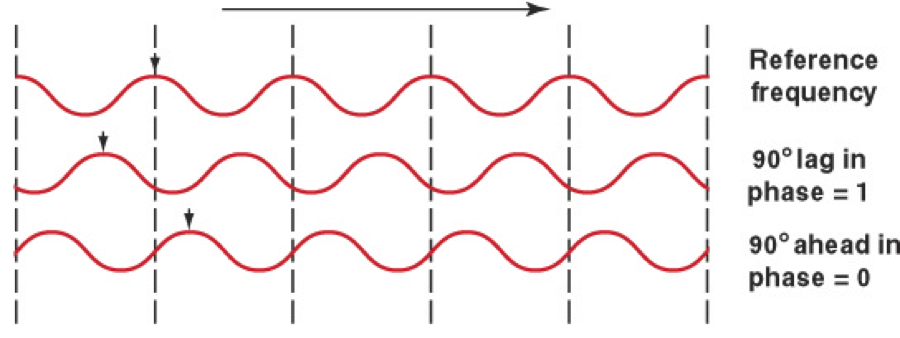
Procedures
We can demonstrate how spacecraft communication works using sounds. We can even send secret messages using drumbeats!
Preparation:
- For this activity, you will need some way to make rhythmic sounds (without echoes or much reverberation). Perhaps your school’s music teacher can help with this activity. You need to be able to make two different sounds, perhaps one low-pitched and one higher-pitched. Here are some example ways to do this:
- Recommended option: For the reference frequency, use a metronome, an electronic keyboard, or a metronome mobile app that can automatically maintain a steady beat. For the signal frequency, use a drum, piano key, ruler tapping on a desk, spoon tapping on a glass of water, or anything that can sound out a beat.
- Alternative option: If you don’t have a metronome or electronic keyboard, then find a way to make two different beat sounds, one lower and one higher, or one louder and one softer.
- The only other materials you will need are paper and pencils, plus the Binary Code Chart so you can translate back and forth from letters or numbers to symbols and bits (1 or 0).
Class Procedure:
- Use the metronome or electronic keyboard, app, or one of the instruments (preferably the lower or louder one) to create an imaginary reference frequency (or beat, in this case). Then, the other instrument will represent the signal. We need to maintain the reference beat so that we humans can make sense of the signal beat.
- If the two instruments are beating together—that is, are in phase—there is no information being transmitted.
- If the signal beat lags an instant behind the reference beat for four beats, that means 1.
- If the signal beat is just an instant ahead of the reference beat for four beats, that means 0. Note: There must be four “in phase” beats to signal the break between bits (1 or 0) for every bit being “transmitted."
- We will call the metronome, electronic keyboard, app or the person with an instrument keeping the reference frequency (or beat) the “Ref.” We will call the person transmitting the signal frequency the “Sig.”
- Ref starts a slow, steady beat — about 45-60 beats per minute. The important thing is that it be very regular. Metronomes or metronome apps are very good at keeping regular beats.
- Now, Sig beats four beats just a little behind Ref. So, using “BUMP” to mean the reference beat and “bump” to mean the signal beat, it sounds sort of like:
BUMP-bump (pause) BUMP-bump (pause) BUMP-bump (pause) BUMP-bump (pause)
Get used to this sound. In this activity, four of these beats means “1.” In the spacecraft business, each beat (or phase-modulated wavelength) is called a symbol. - Now, after these four beats, Sig again gets back in phase with Ref for four beats, so mostly what you’ll hear is:
BUMP (pause) BUMP (pause) BUMP (pause) BUMP (pause)
Note that after Sig’s last beat in the “1” sequence, he or she will have to rush the next beat to be “in sync” with Ref. - Now, without missing a beat, Sig rushes ahead and beats just a little before Ref for four beats, like this:
bump-BUMP (pause) bump-BUMP (pause) bump-BUMP (pause) bump-BUMP (pause)
Get used to this sound, too, because these four beats mean “0.” - Again Sig beats in phase with Ref for four beats. Note that after the last beat of the “0” sequence, Sig has to pause a bit to get back in sync with Ref. All together, this sequence will sound like this:
BUMP (pause) BUMP (pause) BUMP (pause) BUMP (pause)
--------------
BUMP-bump (pause) BUMP-bump (pause) BUMP-bump (pause) BUMP-bump (pause) - [the number 1]
--------------
BUMP (pause) BUMP (pause) BUMP (pause) BUMP (pause)
--------------
bump-BUMP (pause) bump-BUMP (pause) bump-BUMP (pause) bump-BUMP (pause) - [the number 0]
You might have to practice for a while to get the hang of these rhythm sequences. - Now, let’s transmit information! Use the Binary Code Chart showing the standard sequences of bits used by computers to represent each of the letters of the alphabet (capitals only here) and numbers 0-9. We already know it takes four symbols (off-phase beats) to make a bit. Now, in the chart, notice that it takes eight bits (called a byte) to make a letter or number. Since we are using four beats (like wavelengths for a spacecraft) in our game to make a bit (plus four beats between bits), it is going to take 64 beats to make a single letter! This is just how it’s done by a spacecraft. It might take 64 symbols to make a byte of information. Each student needs a copy of the chart.
- Sig picks one letter or number, but keeps it a secret from everyone else. Then, with the metronome or reference beat going, Sig tries to beat out the correct sequence of symbols that will make the 1s and 0s that will communicate the number or letter he or she picked.
- Others in the class must listen very carefully, with pencil and paper at hand. If you are a listener, each time you hear four beats out of phase, write down whether its:
- Now, when the drummer(s) gets very good at this they can put together whole words, even sentences. To signal the break between letters, you can add four more “in phase” beats, for a total of eight. To signal a break between words, you can add another four or eight “in phase” beats, for a total of 12 or 16.
- How quickly can you transmit and receive information before there are lots of errors? This activity begins to give you an idea how any kind and any amount of information can be communicated using only two states: 1/0, on/off, yes/no. This system is called binary (meaning 2) notation. This is the only language computers or spacecraft understand.
A "1"
(BUMP-bump) repeated four times
or a "0"
(bump-BUMP) repeated four times.
When you have 8 bits (1s and 0s), find that sequence on the table and you will know the letter or number Sig was transmitting!
Discussion
- How quickly can you transmit and receive information before there are lots of errors? This activity begins to give you an idea how any kind and any amount of information can be communicated using only two states: 1/0, on/off, yes/no. This system is called binary (meaning 2) notation. This is the only language computers or spacecraft understand.
- Ask students what they found difficult in the role of receiver or "Sig."
- Have students share an idea for speeding up the transmission of letters and numbers (ideas might include speeding up the metronome, creating a new pattern to represent 1 and 0, creating a new pattern to represent each letter and number, or a totally new idea). Optimizing the speed of communication is presented further in "Extensions" below.
Assessment
- Informally assess the class after one set of four beats to determine who hears the pattern correctly and who might need additional support or corrections.
- Collect papers to see where errors are located. A single student with an error likely misheard, or incorrectly received, the signal. But if the entire class has the same error, it was likely a "transmission" error.
- After an initial practice session, time students to see how long it takes them to decode a single letter or short word, and see how their performance improves with practice.
- Compare student transmission and decoding times with times recorded using the optimized system students develop in the "Extensions" section below.
Extensions
- After discussing ideas for speeding up the transmission of letters and numbers, have students work in small groups to come up with ideas about how to optimize the signal speed. All groups should share their ideas for improving and then can carry out the optimization by changing the existing set of patterns or creating a new system. By having students optimize a communication system across the classroom, they will have worked to meet the performance expectation addressed in 4-PS4-3: Generate and compare multiple solutions that use patterns to transfer information. Students will likely have their own ideas, but some examples include Morse code by sound or light, and number patterns other than binary code.
Explore More!
- Visit DSN Now to see which spacecraft are currently communicating with DSN antennas on Earth.
- For more on binary notation and to see how it is used in the computer and space business, visit Space Place.
- Learn more about the Deep Space Network.
This activity was originally published in The Technology Teacher, April 2001, by the International Technology Education Association





